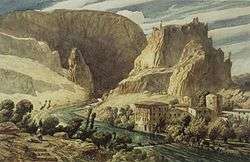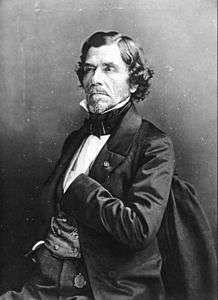Paul Huet
Paul Huet (3 October 1803 – 8 January 1869) was a French painter and printmaker born in Paris. He studied under Gros and Guerin.[1] He met the English painter Richard Parkes Bonington in the studio of Gros, where he studied irregularly from 1819 to 1822.[2] Bonington's example influenced Huet to reject neoclassicism and instead paint landscapes based on close observation of nature.[3] The British landscape paintings exhibited in the Salon of 1824 were a revelation to Huet, who said of Constable's work: "It was the first time perhaps that one felt the freshness, that one saw a luxuriant, verdant nature, without blackness, crudity or mannerism."[4] Huet's subsequent work combined emulation of the English style with inspiration derived from Dutch and Flemish old masters such as Rubens, Jacob van Ruisdael, and Meindert Hobbema.[5]

He exhibited in the Salon for the first time in 1827, when one of the eight paintings he submitted was accepted by the jury.[2] Afterwards he showed at the Salon regularly, and won the support of many important critics. Among his champions was Eugène Delacroix, whom Huet had met In November 1822.[2] Less enthusiastic was Étienne-Jean Delécluze, who criticized Huet as "the painter who has been the most faithful to the principles of Constable, Turner, Daniell and by extension Watteau ... he totally neglects design."[2]
Huet participated in the July Revolution of 1830, and was involved in republican politics for a period afterwards.[6] He was awarded a pair of Sèvres porcelain vases from King Louis-Philippe in 1844.[7] He was awarded a gold medal at the Salon of 1848.[6] He exhibited in the Exposition Universelle of 1855, where he was awarded a medal, and also exhibited in the International Exposition of 1867.[6]
Huet's works, which include oil paintings, watercolors, etchings, and lithographs, are Romantic in feeling.[6] He was unusual among French landscape painters in his use of watercolor for sketching as well as for finished works, which were often so richly developed that they resemble oil paintings.[8] The vividness with which he depicted natural forms influenced the painters of the Barbizon School and later the Impressionists.[3]
Paul Huet died in Paris on 8 January 1869.
Selected works
References
- Clay, J. (1973). Impressionism. Paris: Hachette Réalités. p. 45. ISBN 2010066235
- Noon, Patrick J., and Stephen Bann (2003). Crossing the Channel: British and French painting in the age of Romanticism. London: Tate Pub. p. 107. ISBN 185437513X
- "Paul Huet", The J. Paul Getty Museum
- Noon, Patrick J., and Stephen Bann (2003). Crossing the Channel: British and French painting in the age of Romanticism. London: Tate Pub. p. 196. ISBN 185437513X
- Noon, Patrick J., and Stephen Bann (2003). Crossing the Channel: British and French painting in the age of Romanticism. London: Tate Pub. pp. 107, 205. ISBN 185437513X
- Murray, C. J. (2004). Encyclopedia of the romantic era, 1760-1850. New York: Fitzroy Dearborn. p. 527. ISBN 157958361X
- Sévres vases sold at Christie's in New York on 7 June 2012
- Noon, Patrick J., and Stephen Bann (2003). Crossing the Channel: British and French painting in the age of Romanticism. London: Tate Pub. pp. 241, 264. ISBN 185437513X
